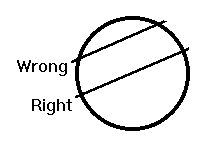Measuring the field of view of an eyepiece and telescope.
Background
When looking through a telescope, it is useful to know how
wide or narrow a view you are seeing. This can help you compare what you are
seeing to your star chart.
Stars travel westward through the sky at the rate of one revolution every 23
hours 56 minutes (86,164 seconds). Stars near the celestial equator (declination
near zero) move most rapidly across the sky. Stars further from the equator,
move more slowly. The adjustment factor is the cos of the star’s declination.
These facts can be used to calculate the field of view (angle of view) through
any combination of eyepiece and telescope. It is known as the drift method.
Observations
- Select any bright star which is near (within about 20° of ) the celestial
equator.
- Look up the declination of the star in an appropriate table.
- Observe the star through the eyepiece-telescope combination you want to
measure.
- Turn off the motor drive. The star will drift due west (on the celestial
sphere).
- Adjust the declination of the telescope so that the star passes right
through the centre of the eyepiece (the widest part).

- Adjust the right-ascension of the telescope so the star is just out of
view on the east edge.
- Let the star drift into view.
- Begin timing when the star first appears.
- Stop timing when the star disappears off the other (west) edge of the
field of view.
- Calculate the elapsed time (drift time).
- Repeat this measurement 2 more times.
- Compare the 3 times to be sure no errors have been made.
Calculations
Find the average time for the 3 measurements. Convert the
average time to an angle of view as follows: (drift time) x cos(star’s declination) x 360°
Field of view = ---------------------------------------------
86,164 seconds
Be sure to use the same units for all
like measurements (usually seconds for time, degrees for angles).
Example
Aldebaran (brightest star in Taurus) has a declination of +16°30"
cos(16°30") = 0.9588
Drift timings:
- 121 seconds
- 119 seconds
- 120 seconds
Average 120 seconds
120 seconds x 0.9588 x 360
Field of View = --------------------------
86164 seconds
= 0.481° = 28’ 51" This is about the size of the Moon.
Every combination of eyepiece and telescope will be different, but in general:
- The longer the focal length of the eyepiece, the larger the field-of-view
(with the same telescope).
- The longer the focal length of the telescope, the smaller the field of
view (with the same eyepiece).
Home

